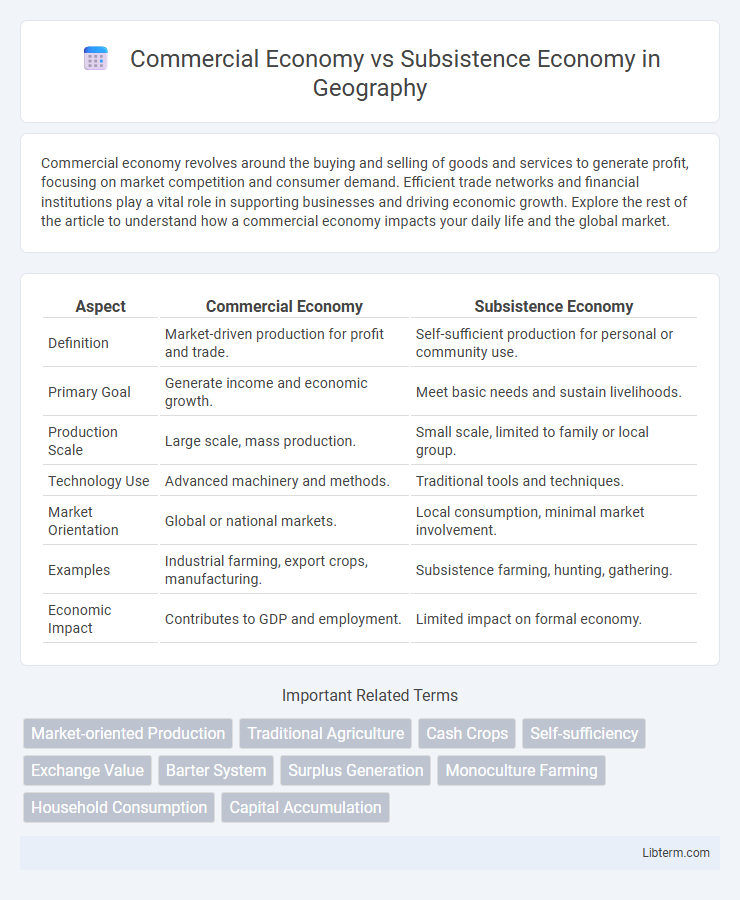Commercial economy revolves around the buying and selling of goods and services to generate profit, focusing on market competition and consumer demand. Efficient trade networks and financial institutions play a vital role in supporting businesses and driving economic growth. Explore the rest of the article to understand how a commercial economy impacts your daily life and the global market.
Table of Comparison
| Aspect | Commercial Economy | Subsistence Economy |
|---|---|---|
| Definition | Market-driven production for profit and trade. | Self-sufficient production for personal or community use. |
| Primary Goal | Generate income and economic growth. | Meet basic needs and sustain livelihoods. |
| Production Scale | Large scale, mass production. | Small scale, limited to family or local group. |
| Technology Use | Advanced machinery and methods. | Traditional tools and techniques. |
| Market Orientation | Global or national markets. | Local consumption, minimal market involvement. |
| Examples | Industrial farming, export crops, manufacturing. | Subsistence farming, hunting, gathering. |
| Economic Impact | Contributes to GDP and employment. | Limited impact on formal economy. |
Definition of Commercial Economy
A commercial economy is characterized by the production and exchange of goods and services primarily for profit, with markets playing a central role in determining prices and distribution. This type of economy relies on specialized labor, widespread trade networks, and capital investment to drive growth and efficiency. Unlike subsistence economies, which focus on self-sufficiency and survival, commercial economies emphasize monetary transactions, economic expansion, and consumer demand.
Definition of Subsistence Economy
A subsistence economy is defined as an economic system where communities primarily produce goods and services to meet their own needs, with minimal surplus for trade or sale. This type of economy relies heavily on agriculture, hunting, gathering, and small-scale production, enabling self-sufficiency without dependence on external markets. In contrast, a commercial economy focuses on producing goods and services for exchange and profit within broader markets.
Key Differences Between Commercial and Subsistence Economies
Commercial economies rely on market exchange and production for profit, emphasizing specialization, large-scale trade, and monetary transactions. Subsistence economies focus on self-sufficiency, where communities produce primarily for their own consumption with minimal surplus and limited external trade. The key differences lie in the scale of production, reliance on market systems, and the primary purpose of economic activity--profit generation versus meeting basic needs.
Historical Background and Evolution
Commercial economies emerged historically with the growth of trade networks and urban centers, enabling the exchange of goods and services beyond local communities. Subsistence economies, rooted in agrarian and hunter-gatherer societies, evolved to sustain families or small groups through direct production for personal use. Over time, the transition from subsistence to commercial economies was driven by technological advances, population growth, and market demand, leading to specialization and economic complexity.
Main Characteristics of Commercial Economies
Commercial economies are characterized by the production of goods and services for exchange in markets, where profit maximization drives economic activities. These economies feature developed financial institutions, extensive trade networks, and specialization of labor to increase efficiency and productivity. High levels of capital investment, technological innovation, and regulatory frameworks support complex transactions and large-scale commerce.
Main Characteristics of Subsistence Economies
Subsistence economies are primarily characterized by self-sufficiency, where communities produce just enough goods and services to meet their own needs, with minimal surplus for trade. These economies rely heavily on traditional techniques, family labor, and natural resource management, often involving hunting, gathering, and subsistence farming. Limited market participation and low levels of technological advancement distinguish subsistence economies from commercial economies focused on profit and large-scale production.
Role of Technology in Both Economies
In a commercial economy, technology drives mass production, efficiency, and global trade integration, enabling businesses to scale operations and innovate rapidly. In contrast, subsistence economies rely on traditional technologies and manual methods tailored to local resources and self-sufficiency, with limited technological advancement. The role of technology in commercial economies is transformative and growth-oriented, whereas in subsistence economies, it is primarily adaptive and sustainability-focused.
Impact on Society and Culture
Commercial economies foster urbanization, social stratification, and cultural exchange by promoting trade, specialization, and wealth accumulation, often leading to greater innovation and cultural diversity. Subsistence economies prioritize self-sufficiency and community cohesion, maintaining traditional practices, social equality, and a strong connection to the environment. The shift from subsistence to commercial economies fundamentally transforms social roles, values, and cultural identities within societies.
Environmental Consequences
Commercial economies drive large-scale production and resource extraction, often leading to deforestation, pollution, and loss of biodiversity due to industrial activities. Subsistence economies, relying on small-scale farming and local resource use, tend to have lower environmental footprints and promote sustainable practices that preserve ecosystems. The environmental consequences of commercial economies are typically more severe, requiring integration of sustainable development strategies to mitigate ecological degradation.
Future Trends and Challenges
Commercial economies are expected to expand through technological advancements like AI and automation, driving efficiency and global trade integration while facing challenges such as market volatility and resource depletion. Subsistence economies will confront sustainability pressures and climate change impacts, pushing for innovative local resource management and climate-resilient agriculture. Both economic systems will need adaptive strategies to balance growth, environmental sustainability, and social equity in an increasingly interconnected world.
Commercial Economy Infographic

 libterm.com
libterm.com